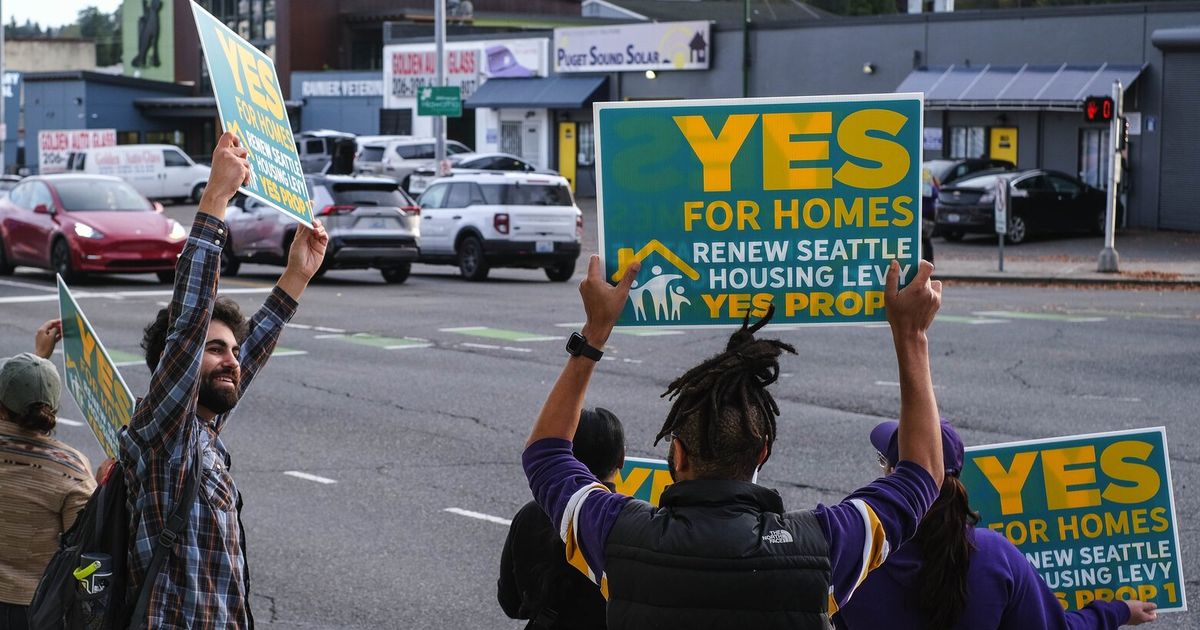Seattle voters to decide on a nearly $1B affordable housing question
Seattle voters to decide on $970M levy to fund affordable housing The Seattle Times


Seattle Voters to Decide on Largest-Ever Property Tax Measure for Affordable Housing

The latest iteration of the Seattle Housing Levy would raise $970 million over seven years, more than triple the existing levy that expires at the end of this year. Supporters say the levy marks a “critical investment” in the city’s housing stock, while the levy’s only prominent skeptic argues for other strategies to address the housing shortage.
“We are in a deepening housing crisis that demands more tools at scale and this levy rises to meet the moment,” said Patience Malaba, a leader of the Yes for Homes campaign and executive director of the Housing Development Consortium.
Even so, Seattle’s need for new affordable housing still far outstrips what the levy is expected to build, underscoring how far Seattle remains from solving its housing and homelessness crises.
Sustainable Development Goals (SDGs)
- Goal 1: No Poverty
- Goal 11: Sustainable Cities and Communities
- Goal 17: Partnerships for the Goals
Over the next 20 years, Seattle is expected to need 3,500 new homes every year for people with low and moderate incomes. The levy is expected to fund 3,200 new homes in that income range over seven years.
If approved, property owners in the city would pay 45 cents per $1,000 of their property’s assessed value. That amounts to about $385 a year for the owner of a median $855,000 home, an increase of about $260 a year from the present levy rate.
Funding Allocation
The levy is one of the city’s primary funding sources for affordable housing, along with a business tax known as JumpStart and developer fees collected under the Mandatory Housing Affordability program.
Levy spending over the next seven years would include:
- About $707 million to help fund construction of about 2,900 new rental homes and renovations to about 600 existing homes. These funds would support housing for people making 60% of area median income, about $57,000 for a single person, or less. At least 60% of this funding would be earmarked for housing that is affordable to people making less than 30% of area median income, or about $29,000 a year for a single person. Affordable is defined as requiring tenants to spend no more than 30% of their income on housing.
- About $51 million to help fund construction of nearly 300 new affordable homes for sale for people making moderate incomes, home repair grants, foreclosure help and mortgage assistance. These funds would benefit programs for people making 80% of area median income, about $71,000 for a single person, or less.
- About $122 million to fund operations of affordable buildings, services for residents and wage increases for social services workers. Some operations funding could also temporarily be loaned to nonprofits buying existing apartment buildings, then repaid to the city and used for operations later in the seven-year life of the levy, according to the Office of Housing.
- An additional $30 million for rent assistance to help tenants avoid eviction.
About 6% of the funds, $60 million, would pay for administration of the levy, including city staff and the costs of maintaining and preparing city-owned properties set to be used for housing development.
Supporters and Opponents
On the ballot roughly every seven years, the housing levy has long been popular with voters. The existing levy — double the cost of its predecessor — passed in 2016 with 71% of the vote.
This year, a campaign in favor of the measure has raised nearly $463,000 as of Wednesday, and there has been no organized opposition campaign. A Seattle Times/Suffolk University poll in June found a majority of respondents supported the levy.
The largest donors in support include the Housing Development Consortium, which has donated $40,000. Developer Matt Griffin, philanthropist Connie Ballmer and Amazon each donated $25,000. Habitat for Humanity Seattle-King and Kittitas Counties donated $10,000 and spent $22,500 on production of a video supporting the measure.
Other big donors include nonprofit and for-profit developers and unions. The political action committee of the Washington Multifamily Housing Association, a landlord lobbying group, donated $10,000.
The levy’s most vocal skeptic is Roger Valdez, director of the pro-development organization Seattle for Growth, who wrote the statement opposing the levy in the county voter guide.
Valdez criticizes Seattle’s existing spending on affordable housing. He argues the city does not have a “coherent, sensible strategy for addressing the underlying issue. And in fact, the city council does things that are exactly the opposite to make things worse, like imposing fees on the construction of new housing.”
Valdez argues the city instead should improve the affordable housing development system, repeal or loosen fees and regulations on private-market developers to encourage more building and focus more on direct payments to people with low incomes, such as universal basic income or rent assistance.
Supporters see the levy as a critical source of funding for deeply subsidized rentals private developers are not building.
“For every unit that’s been built, a household has been housed that wouldn’t have been housed in the [private] market,” said Susan Boyd, CEO of the nonprofit developer Bellwether Housing. “If the market were able to produce things cheaply enough for people to live in with limited income, then it would be doing that and it can’t.”
Affordable housing developments can face higher costs than private projects for an array of reasons, including because of more complex financing that adds time and overhead costs.
Government-funded projects can require higher worker wages, banks may have tighter lending standards for affordable housing, government funding often takes longer and requires regular reporting, and some neighborhood groups may oppose affordable housing, drawing out timelines, according to a 2014 report from the nonprofit Urban Land Institute.
Rising Costs
Beyond bureaucratic hurdles, developers of all kinds of housing are facing rising land prices, construction costs and interest rates.
Due in part to those costs, the levy is not expected to dramatically increase the number of new apartments built per year even as it brings in more tax dollars.
The 2016 measure dedicated $201 million, about 69% of that levy’s total, to building, buying or renovating a promised 2,500 rental homes. The city says it has exceeded those estimates and funded nearly 3
SDGs, Targets, and Indicators
SDGs Addressed:
- SDG 1: No Poverty
- SDG 11: Sustainable Cities and Communities
Targets Identified:
- Target 1.4: By 2030, ensure that all men and women, in particular the poor and the vulnerable, have equal rights to economic resources, as well as access to basic services, ownership, and control over land and other forms of property, inheritance, natural resources, appropriate new technology, and financial services, including microfinance.
- Target 11.1: By 2030, ensure access for all to adequate, safe, and affordable housing and basic services and upgrade slums.
Indicators:
- Indicator 1.4.2: Proportion of total adult population with secure tenure rights to land, with legally recognized documentation and who perceive their rights to land as secure, by sex and by type of tenure.
- Indicator 11.1.1: Proportion of urban population living in slums, informal settlements, or inadequate housing.
Analysis:
The article discusses the Seattle Housing Levy, which aims to raise $970 million over seven years to address the city’s housing and homelessness crises. The issues highlighted in the article are connected to SDG 1 (No Poverty) and SDG 11 (Sustainable Cities and Communities).
Based on the article’s content, the specific targets that can be identified are Target 1.4 (equal rights to economic resources and access to basic services) and Target 11.1 (access to adequate, safe, and affordable housing).
The article mentions indicators that can be used to measure progress towards the identified targets. Indicator 1.4.2 (secure tenure rights to land) can be used to measure progress towards Target 1.4, and Indicator 11.1.1 (proportion of urban population living in slums or inadequate housing) can be used to measure progress towards Target 11.1.
Table: SDGs, Targets, and Indicators
| SDGs | Targets | Indicators |
|---|---|---|
| SDG 1: No Poverty | Target 1.4: By 2030, ensure that all men and women, in particular the poor and the vulnerable, have equal rights to economic resources, as well as access to basic services, ownership, and control over land and other forms of property, inheritance, natural resources, appropriate new technology, and financial services, including microfinance. | Indicator 1.4.2: Proportion of total adult population with secure tenure rights to land, with legally recognized documentation and who perceive their rights to land as secure, by sex and by type of tenure. |
| SDG 11: Sustainable Cities and Communities | Target 11.1: By 2030, ensure access for all to adequate, safe, and affordable housing and basic services and upgrade slums. | Indicator 11.1.1: Proportion of urban population living in slums, informal settlements, or inadequate housing. |
Behold! This splendid article springs forth from the wellspring of knowledge, shaped by a wondrous proprietary AI technology that delved into a vast ocean of data, illuminating the path towards the Sustainable Development Goals. Remember that all rights are reserved by SDG Investors LLC, empowering us to champion progress together.
Source: seattletimes.com

Join us, as fellow seekers of change, on a transformative journey at https://sdgtalks.ai/welcome, where you can become a member and actively contribute to shaping a brighter future.







